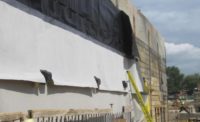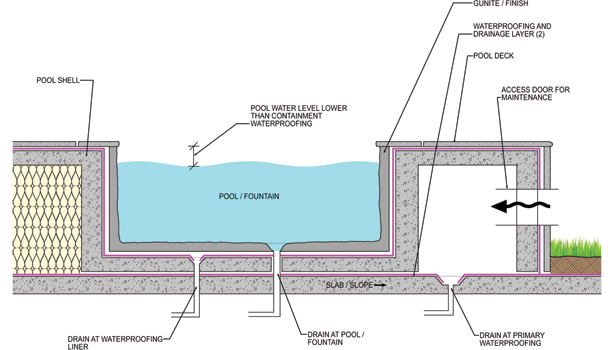Diving Into Fountain and Pool Waterproofing
With Extra Attention, Problems With Fountains and Pools Can Be Averted

Figure 1. Concrete can crack and allow water to enter around a pipe opening.

Fountains and pools place over occupied spaces present a high risk of water penetration, in part because they place a constant and severe performance demand on the waterproofing components. Photos courtesy of Simpson, Gumpertz & Heger.

Figure 2. Sealant is a hole filler. Waterproofing should lap onto and seal to pipe penetrations.

Figure 3. Best practice includes a primary and secondary waterproofing layer.

Figure 4. A rooftop pool lined with hot-applied rubberized asphalt and protection layer.





While rooftop and plaza pools are spectacular on a warm summer day, they flirt with disaster from a waterproofing standpoint. Just like most people have a deep-seated fear of waterbeds popping in the middle of the night, waterproofers’ nightmares are haunted by the potential for pools leaking over super-expensive suede couches or big-screen TVs. Fountains are similar. Take a common scenario: a pool on a central second floor plaza deck located over a parking garage. While picking and installing a waterproofing membrane was relatively straightforward, little planning went into potential membrane failure or maintenance planning. The swimming pool was constructed without access to the waterproofing membrane under the pool shell. Also, the condo association president’s beautiful V-8 two-seater was conveniently parked beneath. Two years after completion, the condo president began to notice orange-colored stains on his car and traced the dripping back to its origin — a drain pipe over his parking spot.
Stories like these show that fountains and pools over occupied space present a high risk of water penetration, in part because they place a constant and severe performance demand on the waterproofing components. Roofs typically only leak when it rains. Pools and fountains, which are permanently filled with several feet of water, can leak constantly. In many cases, fountains and pools must contain a large volume of water above occupied areas for the lifespan of a building. Despite significant performance demands, we have often seen that the waterproofing design and construction of fountains and pools are given less consideration than other building envelope components. With some extra attention, many problems associated with fountains and pools can be averted by using basic building envelope wisdom, such as redundant waterproofing, use of appropriate materials, proper detailing, logical construction sequencing and simple performance testing.
What Can Go Wrong?
To understand how best to design pools and fountains in the future, one must first understand commons failures and problematic organizations of materials. Although failure modes can vary widely, the most frequently occurring can be categorized as follows:
- Improper Waterproofing Selection or Detailing — Water containment is only as good as the container. Continuously bonded waterproofing membranes, which includes practically all fluid-applied membrane systems, are vulnerable to tearing when they are installed over moving cracks, or cracks that develop after the membrane has cured, an effect called “reflective cracking.” Examples are shrinkage cracks in concrete pool shells. Where such cracking is likely to occur, a factory-fabricated sheet membrane that can tolerate some substrate movement is more appropriate. In addition to substrate cracks, the most common cause of leakage is improper detailing of the pool waterproofing at penetrations and perimeter details. Service penetrations that must be flashed into the membrane are particularly susceptible to water penetration (Figure 2).
- Lack of Membrane Drainage — Some waterproofing designs lack a capillary break or drainage layer between the membrane and the pool or fountain liner. Without such a capillary break, the membrane is exposed to the hydrostatic pressure exerted by the water column above. Although waterproofing membranes can withstand this pressure, the lack of drainage virtually ensures that all waterproofing areas are exposed to hydrostatic pressure, and it exposes any membrane weakness or defect in installation.
- Lack of Construction Coordination — Even the most straightforward outdoor pool is a complex system of structural, plumbing, mechanical, waterproofing and architectural finish components that are installed by different professionals. Their work must be carefully coordinated to prevent damage to the waterproofing membrane. We have seen instances where a well-constructed waterproofing membrane was destroyed by anchor penetrations installed during later work.
- Lack of Maintenance — One of the biggest challenges facing designers is planning for pool and fountain maintenance. Pool and fountain drains and circulating equipment may be difficult to access once in-service, unless access doors are provided around the pool perimeter in strategically placed positions. Seals between the waterproofing and pool or fountain equipment may degrade over time and lead to leakage. Where possible, provide access to penetrations and drains for future maintenance. If the design includes a secondary, redundant waterproofing layer, access doors that allow service to drainage of the secondary waterproofing layer are also critical.
- Lack of Design Coordination — Pools and fountains require the design team to resolve where and how the contract documents will convey pool and fountain waterproofing information. Many designs, represented by an architectural plan set and specifications, do not describe the pool and fountain waterproofing in great detail. More typically, pools and fountains will be addressed separately in landscape drawings, which may refer back to architectural drawings for waterproofing information. The architectural drawings, likewise, may refer back to the landscape drawings. In other instances, the fountain or pool will be designed by a specialty consultant who is not a regular participant in the design team. The end result is often a plan set which lacks or contains conflicting information regarding the pools and fountains. Lacking such information, the contractor is often left to sort out detailing and coordination of trade contractors and suppliers under the duress of the construction schedule.
Five Tips for Better Pools and Fountains
A good pool and fountain design will include a durable waterproofing membrane, careful detailing, and a rigorous quality assurance and quality control program. Past failures have also taught designers that two layers of water containment and management are better than one. The five basic tips below can serve as a guide to developing a successful pool and fountain waterproofing strategy.
1. Pick a tough membrane … and use it twice.
Lining a pool or fountain with a durable membrane that has a proven track record is the key to successful performance. Most pools or fountains will include a waterproofing layer over a concrete shell. For most reliable performance, include a drainage layer that separates the membrane from the pool finish, often gunite with tiles. Wherever this approach is practical, such as at rooftop fountains that are elevated above the surrounding deck surface, provide a containment layer of continuous waterproofing below the pool shell (Figure 3).
Tough membranes resist damage during installation of pool and fountain finishes (e.g., concrete or gunite) and resist deterioration in service. They must also allow reliable waterproofing detailing at penetrations. They must include time-proven methods of seam construction, or be seamless altogether. Seams must be able to withstand the constantly wet environment with constant water head pressure. As a general rule, only the most durable and reliable membranes are suitable for water containment or fountains where post-construction waterproofing repairs are impractical. The most reliable roofing and waterproofing membranes are also good candidates for pool waterproofing. We have had successful experience with the following systems:
- Cold or hot fluid-applied field-fabricated membranes: fluid-applied membranes appropriate for pools and fountains consist of high-build materials applied in multiple coats with a reinforcing layer between coats. Most fluid-applied membranes will include a protection layer for applications with pool and fountain finishes, such as gunite. Typical fluid-applied membranes may be rubberized asphalt-based (Figure 4) or polyurethane resin-based. Since these membranes continuously bond to the concrete shell, they also prevent lateral migration of water under the membrane. These membranes have well-established flashing technology that allows construction of reliable penetration details. Resinous fluid-applied membranes often produce less odor during application and are suitable for interior or retrofit applications where the use of a heated kettle is undesirable.
- PVC membranes: PVC, or polyvinyl chloride, membranes are sold in factory-made sheets with reinforcing scrims and will have hot-air welded seams. The PVC membrane will typically also need a protection layer in pool and fountain applications. Because they are produced in a factory and not field-applied, PVC membranes will be of an even quality and thickness. Water that leaks through breaches in loose-laid membranes can migrate long distances, which complicates identification of the leak source and successful membrane repairs. These membranes can use compartmentalization (e.g., fully-adhered membrane strips that create discrete areas of waterproofing) to reduce leak location efforts. In addition to difficulty identifying leaks within loose-laid membrane systems, leaks within these systems will be more severe; small openings in the membrane can lead to large amounts of water penetration because water that has breached the membrane can flow unimpeded under the waterproofing until it finds a way into the space below. Much like a compartmentalized ship takes on less water from breaches in the hull, a compartmentalized waterproofing layer will only allow water travel within a single compartment.
2. Coordinate architectural and landscape drawings.
Understand who is responsible. The architectural and construction industry has not yet established a single traditional location for placing pool or fountain waterproofing information. Sometimes plan sets will include water feature information within the landscape drawings, sometimes within the architectural details, and sometimes nowhere at all. MEP work relating to pools and fountains may not be referenced by or coordinated with the landscape and architectural drawings. To produce a set of contract documents that adequately describes pool and fountain waterproofing, team members can coordinate and subdivide design of pool and fountain waterproofing depending on project requirements. For the best results during construction, the landscape, MEP and architectural drawings should reference each other, as appropriate, and describe each portion of the pool, fountain, and waterproofing only once to avoid disagreement between portions of the drawings set. Discussing expectations before design development will allow the team to coordinate type and placement of pool sections and details. Discussion of the pool waterproofing early on in the design process will also allow the team to review constructability of waterproofing and anticipated sequencing. Depending on the complexity of the project, an integrated “water feature package” that includes all relevant information in one place may be the best solution.
3. Plan for maintenance and access.
Including access doors around MEP penetrations will allow maintenance staff to observe and repair these vulnerable locations. If the design includes an elevated pool or fountain with a continuous secondary membrane, drains that serve the secondary membrane should be accessible to allow for service to unclog or repair them. Locating access areas may be difficult, since pool areas are often highly visible to tenants. Planning early for a concealed, out-of-the-way access area near the liner and structural slab drains will give the maintenance team the best shot at future monitoring and repair.
4. Realize the devil is in the details.
If the pool or fountain has poorly flashed and protected terminations, penetrations and transitions, the likelihood of leakage will be high regardless of membrane selection, coordination and lots of pre-planning. For installation of a successful assembly, the design team must consider the following conditions:
- Drainage: The waterproofing design must include provisions for effective drainage. These include substrate slope and a continuous drainage layer between the waterproofing membrane and the pool liner. The drainage layer must be protected during the installation of the pool liner to prevent clogging. At the lowest point of the pool or fountain, the waterproofing membrane and drainage layer must empty into internal drains. These drains serve only the waterproofing and are distinct from the drains that serve the pool. If the design includes a pool shell and redundant layer of continuous waterproofing below it, this layer of waterproofing must also be drained.
- Waterproofing penetrations: Almost all projects will require plumbing pipes that penetrate the waterproofing membrane in the pool or fountain. Gunite liners require steel reinforcement that will penetrate the waterproofing because it must be attached to the walls of the pool shell. The design should avoid unnecessary penetrations, and all membrane penetrations must be carefully detailed into the waterproofing. The plan set should include pool penetration details.
- Protection: The membrane over the concrete pool or fountain shell should be covered with a dedicated protection board and a thick drainage layer. The entire waterproofing system must be carefully protected during the installation of the gunite pool liner to prevent membrane damage.
- Perimeter conditions: Thinking through the perimeter pool or fountain conditions will help prevent a coordination headache or mistakes during construction. The pool waterproofing must extend several inches above the anticipated in-service water level.
5. Test it before covering it up.
The membrane, including all penetration and tie-in details, must be successfully water tested prior to the installation of the finishes by filling the pool or fountain with water to the expected in-service water level. Many contractors skip this step because it is disruptive and time consuming, but it is the most critical quality assurance tool because it marks the last opportunity to perform membrane repairs. After the successful test, the waterproofing must be carefully protected from damage. We have seen instances where membrane penetrations installed after a successful test caused leakage, and projects where, bowing to schedule pressure, the gunite pool finishes were installed over a membrane that had failed several water tests.
What to Do if Things Go Wrong
When confronted with a leaking pool or fountain, repair options are limited. For pools, a common repair strategy includes overlaying the pool finishes with a PVC membrane. The addition of a PVC liner introduces a new waterproofing layer accessible for future repairs, if necessary. Many PVC liners may include a texturized or patterned surface to meet aesthetic needs. For pools or fountains where the leaks are accessible at cracks, grout injection may be a possibility. A single round of injection may not resolve all leaks, and the injection process is usually iterative to be successful. Lastly, instead of repair, owners may manage and conceal leaks with an internal drainage system of catch pans.
Pool and fountain waterproofing will be inaccessible after completion of construction, making waterproofing repairs and maintenance complicated and costly compared to exposed membrane roofing systems. For pool and fountain waterproofing to be successful, the waterproofing must last for many years. Designers must focus on selecting a durable waterproofing membrane, coordinating project documents to communicate design intent, and apply common sense strategies for a successful pool or fountain installation. Time-tested waterproofing strategies include built-in redundancy, effective drainage, allowance for monitoring and maintenance, and vigilant quality control efforts during construction.
Looking for a reprint of this article?
From high-res PDFs to custom plaques, order your copy today!












